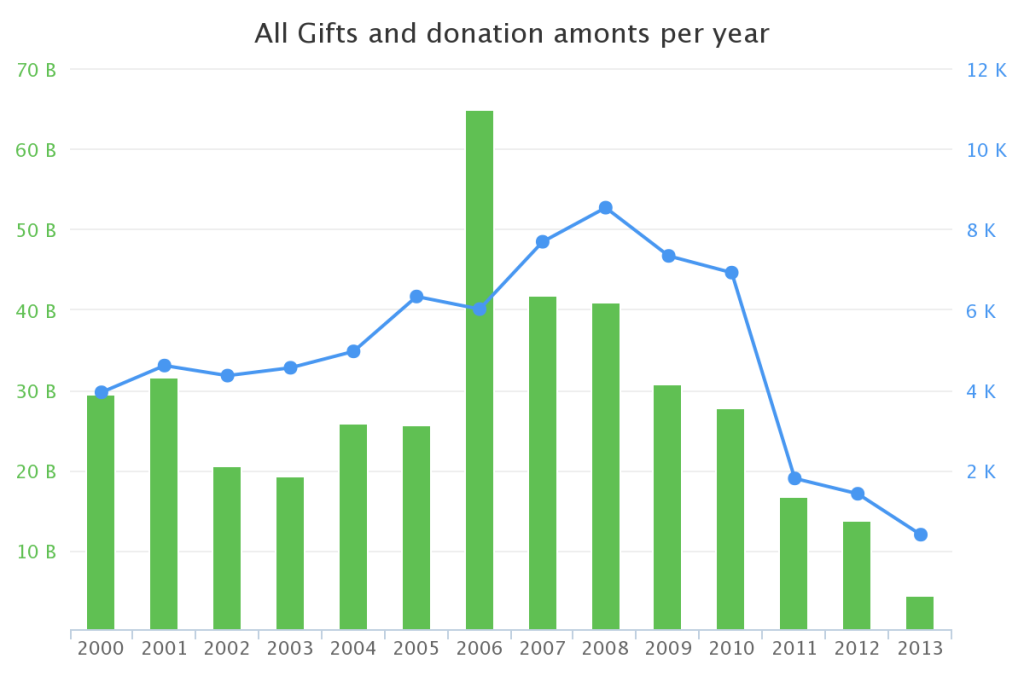The 2013 Giving USA Research report has been issued and as always is receiving a good bit of attention. And, for good reason. The continuing research of Giving USA is a valuable tool for our profession and the philanthropic sector.
Many development officers can quote the segmentation of donor types, or in other words, where the money comes from. Again, a valuable piece of information. But, there are other important nuggets available as well.
The Indiana University Fund Raising School (Lilly Family School of Philanthropy) is continuing the work of Arthur C. Frantzreb, who kept a record of gifts of $1 million and higher for 33 years. This list is now a searchable database, and provides extremely valuable insight to where the really big gifts come from. You might be surprised to learn that it is not the same as the Giving USA results.
Both data sets are important, depending on what you’re doing and what stage of a campaign you may be in. As fundraising counsel, we must often set the stage for major capital fundraising campaigns. As campaign goals in general have increased over the past years, these efforts require the identification of million dollar gifts.
Our advice . . . be informed, and study both sets of data.
You can learn more, here: http://www.milliondollarlist.org/initial-findings and here: http://www.milliondollarlist.org/data
And here is a brief outline of what you’ll find.
About
The current list is a record of publicly announced charitable gifts of $1 million or more since 2000 given by U.S. residents, corporations, private foundations, and other grantmaking nonprofits to domestic or international entities across a range of charitable subsectors. The list is updated on an ongoing basis.
The goal of this project is to create an accurate picture of large gifts and how they fit into the landscape of giving in general. Data for the list come from donors and organizations that self-report, and from media reports and other publicly available sources researched by the Indiana University Lilly Family School of Philanthropy.
The searchable database contains information on donor characteristics, amounts given, donor and recipient locations, specific subsectors to which gifts were given, and additional descriptive information where possible.
This resource offers direct access to the data, interactive charts and maps, and graphic representations of key aspects of the data.
The Million Dollar List is one of the many ways the Lilly Family School of Philanthropy improves philanthropy to improve the world.
Why is this information important?
Inform – There is a lack of knowledge about gifts at the million dollar level. Now, by making the Million Dollar List available online without a subscription, the School of Philanthropy hopes to help fill existing knowledge gaps, highlight patterns and trends, and expand the nation’s understanding of million dollar giving specifically and of philanthropy generally. The Million Dollar List increases transparency, demonstrates the scope of giving at this level, and helps people interested million dollar giving put gifts into context.
Connect – Million dollar gifts represent an important threshold for donors. The Million Dollar List allows donors and advisors to see which organizations with causes similar to their interests are receiving large gifts, where their peers are giving, and where gaps in funding at this level may exist, allowing them to be more strategic in their philanthropy. Additionally, they can find like-minded donors and identify potential opportunities to collaborate to leverage their giving.
History of the Million Dollar ListThe project was conceived by Arthur C. Frantzreb, who kept a record of gifts of $1 million and higher for 33 years. In 1999, the School of Philanthropy agreed to compile and distribute the Million Dollar List to carry on Frantzreb’s work as a service to fundraisers, a record for historians and an inspiration for potential donors. The School converted the subscription-only list to a free online resource in May 2011.
Here is the full report: the-million-dollar-list-methodology-and-summary-statistics-2011

